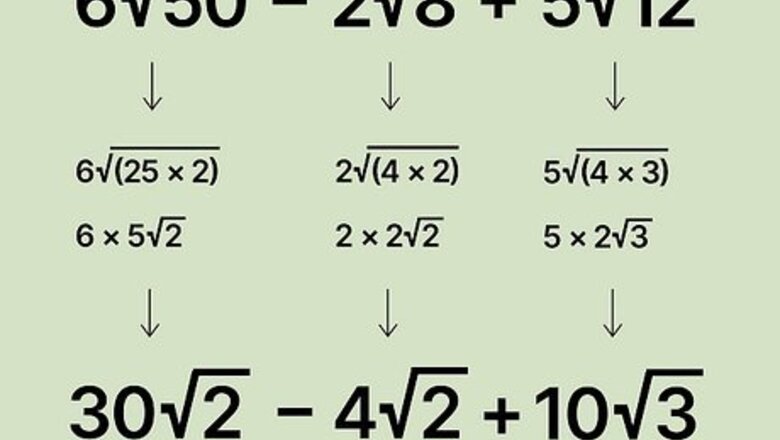
views
Getting the Basics Down
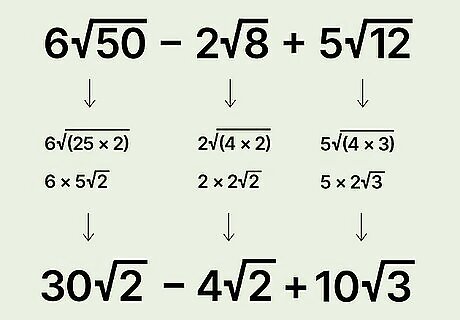
Simplify any terms inside the radicals when possible. To simplify the terms inside of the radicals, try to factor them to find at least one term that is a perfect square, such as 25 (5 x 5) or 9 (3 x 3). Once you do that, then you can take the square root of the perfect square and write it outside the radical, leaving the remaining factor inside the radical. For this example, we are working with the problem 6√50 - 2√8 + 5√12. The numbers outside the radical sign are the coefficients and the numbers inside it are the radicands. Here's how you simplify each of the terms: 6√50 = 6√(25 x 2) = (6 x 5)√2 = 30√2. Here, you've factored "50" into "25 x 2" and then have pulled out the "5" from the perfect square, "25", and placed it outside of the radical, with the "2" remaining on the inside. Then, you multiplied "5" by "6", the number already outside the radical, to get 30 as the new coefficient. 2√8 = 2√(4 x 2) = (2 x 2)√2 = 4√2. Here, you've factored "8" into "4 x 2" and then have pulled out the "2" from the perfect square "4" and placed it outside the radical, leaving the "2" on the inside. Then, you multiplied "2" by "2", the number already outside the radical, to get 4 as the new coefficient. 5√12 = 5√(4 x 3) = (5 x 2)√3 = 10√3. Here, you've factored "12" into "4 x 3" and have pulled out the "2" from the perfect square "4" and placed it outside the radical, leaving the factor "3" on the inside. Then, you multiplied "2" by "5", the number already outside the radical, to get 10 as the new coefficient.

Circle any terms with matching radicands. Once you simplified the radicands of the terms you were given, you were left with the following equation: 30√2 - 4√2 + 10√3. Since you can only add or subtract like terms, you should circle the terms that have the same radical, which in this example are 30√2 and 4√2. You can think of this as being similar to adding or subtracting fractions, where you can only add or subtract the terms if the denominators are the same.
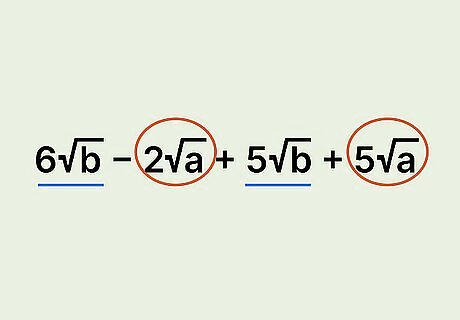
If you're working with a longer equation and there are multiple pairs with matching radicands, then you can circle the first pair, underline the second, put an asterisk by the third, and so on. Lining the terms up in order will make it easier for you to visualize the solution, too.
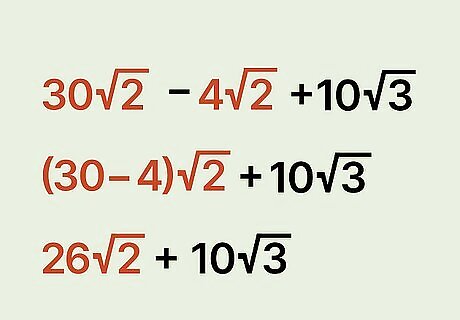
Add or subtract the coefficients of the terms with matching radicands. Now, all you have to do is to add or subtract the coefficients of the terms with the matching radicands and leave any additional terms as part of the equation. Do not combine the radicands. The idea is that you are saying how many of that type of radicand there are, total. The non-matching terms can stay as they are. Here's what you do: 30√2 - 4√2 + 10√3 = (30 - 4)√2 + 10√3 = 26√2 + 10√3
Getting More Practice
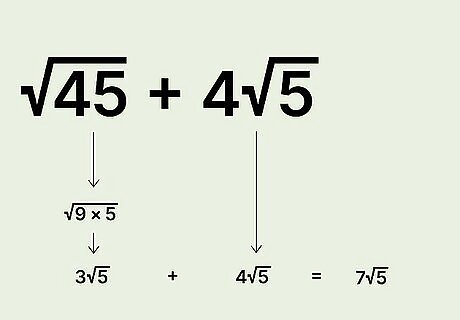
Do Example 1. In this example, you are adding the following square roots: √(45) + 4√5. Here is what you have to do: Simplify √(45). First, you can factor it out to get √(9 x 5). Then, you can pull out a "3" from the perfect square, "9," and make it the coefficient of the radical. So, √(45) = 3√5. Now, just add up the coefficients of the two terms with matching radicands to get your answer. 3√5 + 4√5 = 7√5
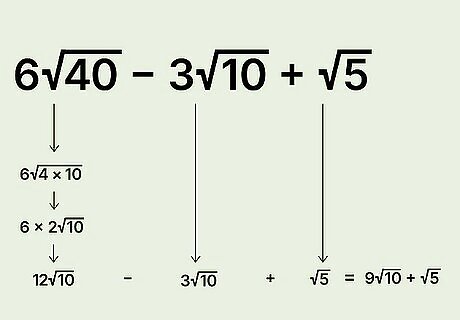
Do Example 2. This example is the following problem: 6√(40) - 3√(10) + √5. Here is what you have to do to solve it: Simplify 6√(40). First you can factor out "40" to get "4 x 10", which makes 6√(40) = 6√(4 x 10). Then, you can pull out a "2" from the perfect square, "4," and then multiply it by the current coefficient. Now you've got 6√(4 x 10) = (6 x 2)√10. Multiply the two coefficients to get 12√10. Now, your problem reads 12√10 - 3√(10) + √5. Since the first two terms have the same radicand, you can subtract the second term from the first and leave the third as it is. You're left with (12-3)√10 + √5, which can be simplified to 9√10 + √5.
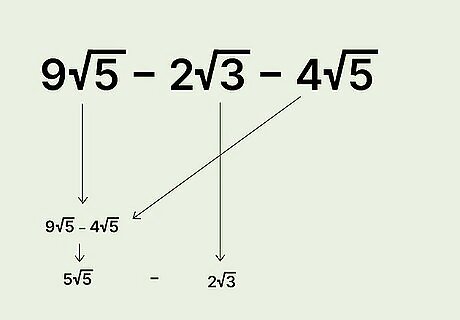
Do Example 3. This example is the following: 9√5 -2√3 - 4√5. Here, none of the radicals have factors that are perfect squares, so no simplifying is possible. The first and third terms are like radicals, so their coefficients can already be combined (9 - 4). The radicand is unaffected. The remaining terms are not alike, so the problem can be simplified as 5√5 - 2√3.
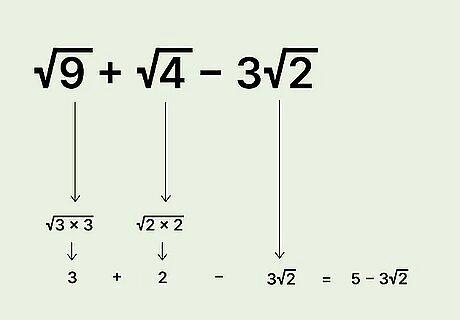
Do Example 4. Let's say you're working with the following problem: √9 + √4 - 3√2. Here is what you do: Since √9 is equal to √(3 x 3), you can simplify √9 to 3. Since √4 is equal to √(2 x 2), you can simplify √4 to 2. Now, you can simply add 3 + 2 to get 5. Since 5 and 3√2 are not like terms, there's nothing more you can do. Your final answer is 5 - 3√2.
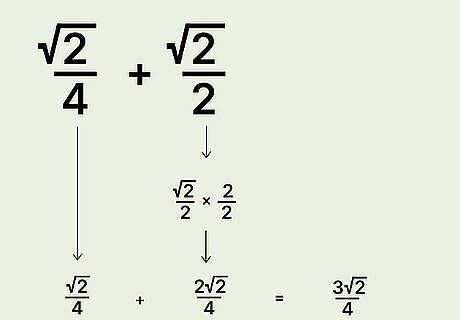
Do Example 5. Let's try adding and subtracting square roots that are part of a fraction. Now, as with a regular fraction, you can only add or subtract fractions that have the same numerator or denominator. Let's say you're working with this problem: (√2)/4 + (√2)/2. Here's what you do: Make it so these terms have the same denominator. The lowest common denominator, or the denominator that would be evenly divisible by both the denominators "4" and "2," is "4." So, to make the second term, (√2)/2, have the denominator of 4, you need to multiply both its numerator and denominator by 2/2. (√2)/2 x 2/2 = (2√2)/4. Add up the numerators of the fractions while leaving the denominator the same. Do just what you would do if you were adding fractions. (√2)/4 + (2√2)/4 = 3√2)/4.



















Comments
0 comment